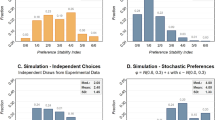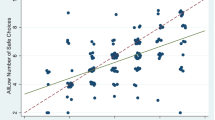Abstract
Risk attitude is known to be a key determinant of various economic and financial choices. Behavioral studies that aim to evaluate the role of risk attitudes in contexts of this type, therefore, require tools for measuring individual risk tolerance. Recent developments in decision theory provide such tools. However, the methods available can be time consuming. As a result, some practitioners might have an incentive to prefer “fast and frugal” methods to clean but more costly methods. In this article, we focus on a tractable procedure initially proposed by Holt and Laury (2002) to elicit risk attitude. We generalize this method to measure utility and risk aversion as follows. First, we allow measurement of probabilistic risk attitude through violations of expected utility due to probability weighting. Second, we use the outcome scale rather than the probability scale in the menu of choices. Third, we compare sure payoffs with lotteries instead of comparing non-degenerate lotteries. A within-subject experimental study illustrates the gains in tractability and bias minimization that can result from such an extension.
Similar content being viewed by others
References
Abdellaoui M. (2000) Parameter-free elicitation of utility and probability weighting functions. Management Science 46: 1497–1512
Abdellaoui M., Barrios C., Wakker P. (2007a) Reconciling introspective utility with revealed preference: Experimental arguments based on prospect theory. Journal of Econometrics 138: 356–378
Abdellaoui M., Bleichrodt H., Paraschiv C. (2007b) Loss aversion under prospect theory: A parameter-free measurement. Management Science 53: 1659–1674
Abdellaoui M., Bleichrodt H., L’Haridon O. (2008) A tractable method to measure utility and loss aversion under prospect theory. Journal of Risk and Uncertainty 36: 245–266
Abdellaoui, M., L’Haridon, O., & Paraschiv, C. (2009). Experienced versus described uncertainty: Do we need two prospect theory specifications? Working Paper, HEC School of Management.
Andersen S., Harrison G., Lau M., Rutström E. (2006) Elicitation using multiple price lists. Experimental Economics 9: 383–405
Andersen S., Harrison G., Lau M., Rutström E. (2008) Eliciting risk and time preferences. Econometrica 76: 583–618
Baillon, A., Drissen, B., & Wakker, P. (2009). Relative concave utility for risk and ambiguity. Working Paper, Erasmus University Rotterdam
Birnbaum M. (2008) New paradoxes of risky decision making. Psychological Review 115: 463–501
Bleichrodt H., Pinto J. (2000) A parameter-free elicitation of the probability weighting function in medical decision analysis. Management Science 46: 1485–1496
Bleichrodt H., Abellan-Perpinan J., Pinto J., Mendez-Martinez I. (2007) Resolving inconsistencies in utility measurment under risk: Tests of generalizations of expected utility. Management Science 53: 469–482
Bosch-Domenech, A., & Silvestre, J. (2006). Risk aversion and embedding bias. Economics Working Papers from Department of Economics and Business, Universitat Pompeu Fabra.
Camerer C., Ho T. (1994) Violations of betweenness axiom and nonlinearity in probability. Journal of Risk and Uncertainty 8: 167–196
Carbone E., Hey J. (2000) Which error story is best?. Journal of Risk and Uncertainty 20: 161–176
Cohen M., Jaffray J.-Y., Saïd T. (1987) Experimental comparison of individual behavior under risk and under uncertainty for gains and for losses. Organizational Behavior and Human Decision Processes 39: 1–22
Diecidue E., Wakker P. (2001) On the intuition of rank-dependent utility. Journal of Risk and Uncertainty 23: 281–298
Erev I., Glozman I., Hertwig R. (2008) What impacts the impact of rare events. Journal of Risk and Uncertainty 36: 153–177
Goeree J., Holt C., Palfrey T. (2003) Risk averse behavior in generalized matching pennies games. Games and Economic Behavior 45: 97–113
Goldstein W., Einhorn H. (1987) Expression theory and the preference reversal phenomena. Psychological Review 94: 236–254
Gonzalez R., Wu G. (1999) On the shape of the probability weighting function. Cognitive Psychology 38: 129–166
Harrison G., List J., Towe C. (2007) Naturally occurring preferences and exogenous laboratory experiments: A case study of risk aversion. Econometrica 75: 433–458
Harrison, G., Ruström, E. (2008) Risk aversion in experiments. In N. Cox, & G. Harrison (Eds.), Risk aversion in the laboratory. No. 12 in research in experimental economic. Bingley: Emerald.
Hershey J., Schoemaker P. (1985) Probability versus certainty equivalence methods in utility measurement: Are they equivalent?. Management Science 31: 1213–1231
Hey J., Orme C. (1994) Investigating generalizations of expected utility theory using experimental data. Econometrica 62: 1391–1426
Holt C., Laury S. (2002) Risk aversion and incentive effects. American Economic Review 92: 1644–1655
Kahneman D., Tversky A. (1979) Prospect theory: An analysis of decision under risk. Econometrica 47: 263–291
Lusk J., Coble K. (2005) Risk perceptions, risk preference, and acceptance of risky food. American Journal of Agricultural Economics 87: 393–405
McCord M., de Neufville R. (1986) Lottery equivalents: Reduction of the certainty effect problem in utility assessment. Management Science 32: 56–60
Morgenstern O., von Neumann J. (1944) Theory of games and economic behavior (2nd ed.). Princeton University Press, Princeton
Noussair C., Wu P. (2006) Risk tolerance in the present and the future: An experimental study. Managerial and Decision Economics 27: 401–412
Prelec D. (1998) The probability weighting function. Econometrica 66: 497–528
Quiggin J. (1982) A theory of anticipated utility. Journal of Economic Behaviour and Organization 3: 323–343
Quiggin J. (1993) Generalized expected utility theory—The rank-dependent model. Kluwer Academic, Dordrecht
Schubert R., Brown M., Gysler M., Brachinger H. (1999) Financial decision-making: Are women really more risk-averse?. American Economic Review 89: 381–385
Starmer C. (2000) Developments in non-expected utility theory: The hunt for a descriptive theory of choice under risk. Journal of Economic Literature 28: 332–382
Stott H. (2006) Cumulative prospect theory’s functional menagerie. Journal of Risk and Uncertainty 32: 101–130
Tversky A., Kahneman D. (1992) Advances in prospect theory: Cumulative representation of uncertainty. Journal of Risk and Uncertainty 5: 297–323
Wakker, P., & Deneffe, D. (1996). Eliciting von neumann-morgenstern utilities when probabilities are distorted or unknown. Management Science, 42.
Author information
Authors and Affiliations
Corresponding author
Additional information
We thank Aurélien Baillon and Enrico Dieccidue for helpful comments. Mohammed Abedellaoui and Olivier L’Haridon’s research was supported by the French National Research Agency (ANR Grant Risk Attitude ANR05-BLAN-0345-01).
Rights and permissions
About this article
Cite this article
Abdellaoui, M., Driouchi, A. & L’Haridon, O. Risk aversion elicitation: reconciling tractability and bias minimization. Theory Decis 71, 63–80 (2011). https://doi.org/10.1007/s11238-009-9192-9
Published:
Issue Date:
DOI: https://doi.org/10.1007/s11238-009-9192-9




